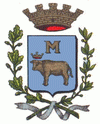Matera (Provincia di Matera)
 |
As the capital of the province of Matera, its original settlement lies in two canyons carved by the Gravina River. This area, the Sassi di Matera, is a complex of cave dwellings carved into the ancient river canyon. Over the course of its history, Matera has been occupied by Romans, Longobards, Byzantines, Saracens, Swabians, Angevins, Aragonese, and Bourbons.
By the late 1800s, Matera's cave dwellings became noted for intractable poverty, poor sanitation, meager working conditions, and rampant disease. Evacuated in 1952, the population was relocated to modern housing, and the Sassi (Italian for "stones") lay abandoned until the 1980s. Renewed vision and investment led to the cave dwellings becoming a noted historic tourism destination, with hotels, small museums and restaurants – and a vibrant arts community.
Known as la città sotterranea ("the underground city"), the Sassi and the park of the Rupestrian Churches were named a UNESCO World Heritage Site in 1993. In 2019, Matera was declared a European Capital of Culture.
Though scholars continue to debate the date the dwellings were first occupied in Matera, and the continuity of their subsequent occupation, the area of what is now Matera is believed to have been settled since the Palaeolithic (10th millennium BC). This makes it potentially one of the oldest continually inhabited settlements in the world. Alternatively it has been suggested by architectural historian Anne Parmly Toxey that the area has been "occupied continuously for at least three millennia".
The town of Matera was founded by the Roman Lucius Caecilius Metellus in 251 BC who called it Matheola. In AD 664 Matera was conquered by the Lombards and became part of the Duchy of Benevento. Architectural historian Anne Parmly Toxey writes that "The date of Matera's founding is debated; however, the revered work of the city’s early chroniclers provides numerous, generally accepted accounts of Goth, Longobard, Byzantine, and Saracen sieges of the city beginning in the eighth century and accelerating through the ninth century AD." In the 7th and 8th centuries the nearby grottos were colonised by both Benedictine and Basilian monastic institutions. The 9th and 10th centuries were characterised by the struggle between the Byzantines and the German emperors, including Louis II, who partially destroyed the city. After the settlement of the Normans in Apulia, Matera was ruled by William Iron-Arm from 1043.
After a short communal phase and a series of pestilences and earthquakes, the city became an Aragonese possession in the 15th century, and was given in fief to the barons of the Tramontano family. In 1514, however, the population rebelled against the oppression and killed Count Giovanni Carlo Tramontano. In the 17th century Matera was handed over to the Orsini and then became part of the Terra d'Otranto, in Apulia. Later it was capital of the province of Basilicata, a position it retained until 1806, when Joseph Bonaparte assigned it to Potenza.
In 1927, it became capital of the new province of Matera.
Map - Matera (Provincia di Matera)
Map
Country - Italy
 |
 |
| Flag of Italy | |
Italy was the native place of many civilizations such as the Italic peoples and the Etruscans, while due to its central geographic location in Southern Europe and the Mediterranean, the country has also historically been home to myriad peoples and cultures, who immigrated to the peninsula throughout history. The Latins, native of central Italy, formed the Roman Kingdom in the 8th century BC, which eventually became a republic with a government of the Senate and the People. The Roman Republic initially conquered and assimilated its neighbours on the Italian peninsula, eventually expanding and conquering a large part of Europe, North Africa and Western Asia. By the first century BC, the Roman Empire emerged as the dominant power in the Mediterranean Basin and became a leading cultural, political and religious centre, inaugurating the Pax Romana, a period of more than 200 years during which Italy's law, technology, economy, art, and literature developed.
Currency / Language
| ISO | Currency | Symbol | Significant figures |
|---|---|---|---|
| EUR | Euro | € | 2 |
| ISO | Language |
|---|---|
| CA | Catalan language |
| CO | Corsican language |
| FR | French language |
| DE | German language |
| IT | Italian language |
| SC | Sardinian language |
| SL | Slovene language |





























